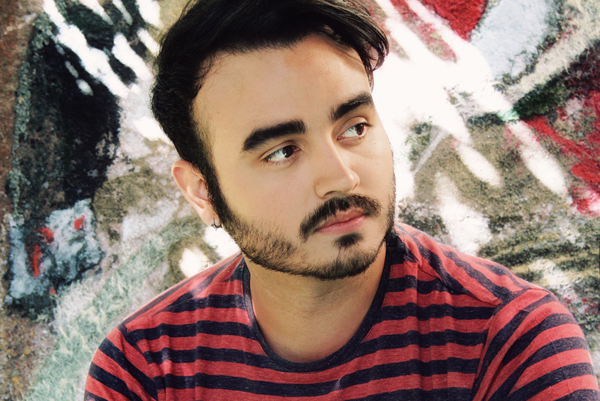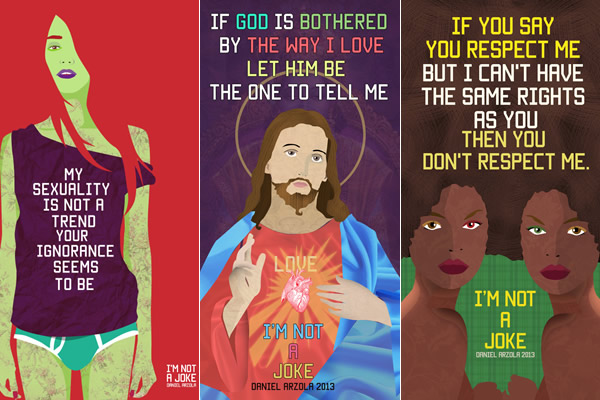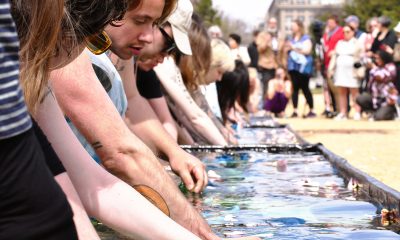Arts & Entertainment
Gay Venezuelan ‘artivist’ fights homophobia, discrimination
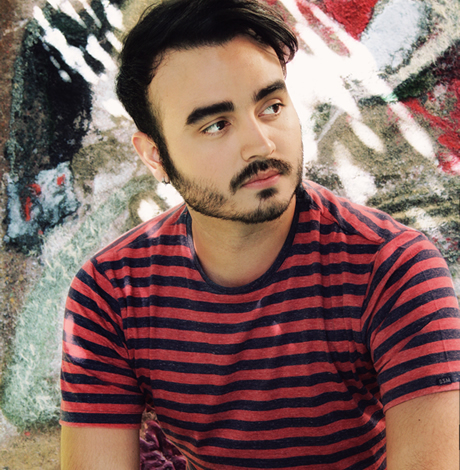
Daniel Arzola is behind the “I’m Not a Joke” campaign, which features a series of 50 posters that contain a sentence and a digital illustration.
The campaign — known as “No soy tu chiste” in Spanish — has appeared in the U.S., Venezuela, Brazil, Australia, Uganda, Russia and two dozen other countries around the world. Arzola’s posters have also been translated into English, Portuguese and 18 other languages.
“It’s about being different,” Arzola told the Washington Blade on April 14 during an interview at Amherst College where an LGBT student group had invited him to speak.
Katy Perry selected several of Arzola’s posters for Madonna’s Art for Freedom, a project for which she is a guest curator.
Arzola told the Blade that his life changed when Madonna tweeted a picture of one of them on Oct. 8, 2013.
“At that moment ‘I’m Not a Joke’ was not only for activists,” said Arzola. “I received a lot of interview (requests) from a lot of countries. And the people from Venezuela who hate me knew my work because Madonna made that tweet.”
“It’s a little cliché but Madonna changed my life,” he added.
‘They tried to burn me alive’
Arzola, 26, grew up in Maracay, a city that is roughly 70 miles south southwest of the Venezuelan capital of Caracas.
Arzola, who has an older brother, told the Blade that he was a “very shy” and “lonely” child. He said that he used “art to communicate with other people.”
“If I liked you, I preferred to give you (a drawing) than to talk to you,” said Arzola.
Arzola said he came out to his mother when he was 5, telling her that he liked a boy in his kindergarten class.
“I told her and she beat me,” said Arzola.
Arzola told the Blade that his mother, who is a teacher, is “not homophobic anymore.” He said she now wears a t-shirt that promotes his art in her classroom.
“She’s like my biggest fan all the time,” said Arzola.
Arzola said that three of his neighbors attacked him when he was 15.
He told the Blade that they took off his pants and shoes before tying him to a telephone poll with cables. Arzola said he was able to escape when one of his attackers tried to find gasoline to set him on fire.
He told the Blade that his assailants destroyed all of his drawings.
“They tried to burn me alive because that’s the way that some people in Venezuela react to the differences in another person,” Arzola told the Blade. “It’s not only if you’re gay.”
Arzola said he was unable to draw for the next six years “until one day I understood that my story is not the only story and I had the luck to escape and survive.” He told the Blade that an 18-year-old man from Maracay who was attacked because of his sexual orientation suffered burns over nearly 50 percent of his body.
“There’s a lot of people burning people alive or hurting other people in Venezuela for being gay,” said Arzola.
The U.N. Office on Drugs and Crime notes that Venezuela has one of the world’s highest homicide rates. A deepening economic crisis has caused a shortage of basic goods, triple-digit inflation and growing political and social instability.
Tamara Adrián, a Caracas lawyer who is a member of Popular Will, a left-leaning party, in December became the first openly trans person elected to the Venezuelan National Assembly. Anti-LGBT violence and discrimination remains pervasive in the South American country in spite of this historic election.
Arzola, who studied graphic design and art in Venezuela, told the Blade that he wanted to use art as a way to challenge anti-gay violence and homophobia in his homeland.
“This is the way that artivism burns in my head,” he said. “I need to fight violence with other things and in Venezuela being gay is always in the media. People laugh about being LGBT, so I was wondering (about) when we start to laugh about tragedy, about the pain of others. In Venezuela people are always saying that, ‘We’re so cool because we find a joke in everything.’ But that everything sometimes includes the pain of others.”
“That’s where the name ‘I’m Not a Joke’” comes in,” added Arzola. “I want to talk with people like you and me, so I’m not your joke. I’m not a joke.”
Threats forced Arzola to move to Chile
Arzola told the Blade that he began to receive threats because of his art and advocacy.
“I had to leave Venezuela because of threats,” he said. “When ‘I’m Not a Joke’ started to be so famous I had the opportunity to talk to so many media, so I exposed the government and the homophobia in Venezuela.”
Arzola met Jaime Parada — a Chilean LGBT rights advocate who became the first out candidate elected to public office in the South American country in 2012 when he won a seat on the Providencia Municipal Council in Santiago — in 2014 during a trip to Buenos Aires.
Arzola moved to Santiago, which is the Chilean capital, in April 2015. He now lives in Providencia — a wealthy Santiago enclave — and works for the municipal government.
“I like Santiago,” Arzola told the Blade. “It’s the first time in my life I have experienced peace…and for me it’s something new. For me it’s very weird being in my bed without fear.”
“For me coming from the chaos in Venezuela and being in Providencia is like, ‘Oh yeah. I create all the time with chaos and now I am in peace. I’m like, what should I do now?’” he added. “I don’t know what to do with so much peace. I’m still creating.”
Theater
Jessica Phillips shines in ‘Penelope,’ a ‘pandemic parable’
Alex Bechtel was inspired to write about loneliness, waiting, separation
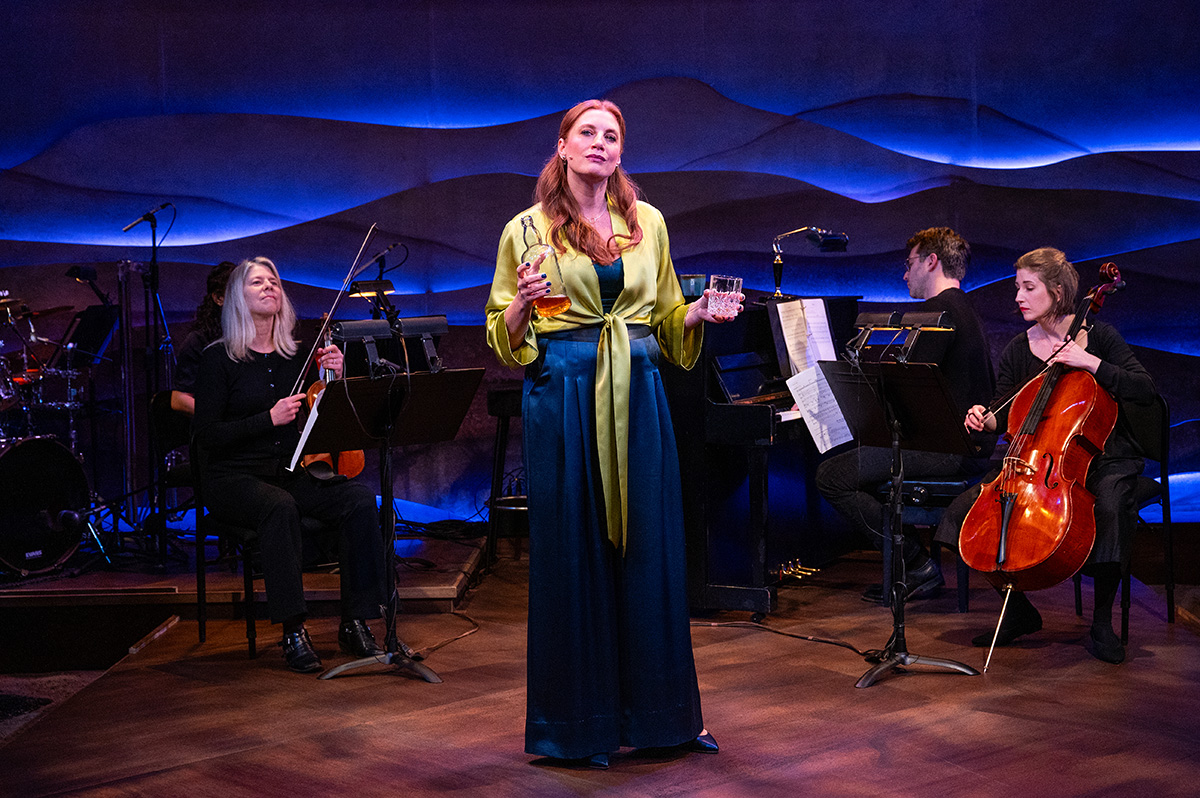
‘Penelope’
Thorough April 28
Signature Theatre, the Ark
4200 Campbell Ave, Arlington
$40-$99
Sigtheatre.org
In the new musical “Penelope,” Broadway’s Jessica Phillips gives an unforgettable take on the title role torn from the pages of Homer’s “Odyssey” — more or less. Fortified by bourbon and backed by a Greek chorus of musicians, the character uncharacteristically steps out from the background to share her story surrounding two decades waiting on the island kingdom of Ithica for the return of her absent husband Odysseus.
Sometimes described as a “pandemic parable,” the 70-minute work is based on composer/playwright Alex Bechtel’s personal experience. While separated from his partner during COVID, he was inspired to write about loneliness, waiting, and separation, a subject Phillips was eager to tackle.
An accomplished Broadway actor and mother of two, Phillips, 52, is best known for memorable turns in “Dear Evan Hansen,” “The Scarlet Pimpernel,” “Next to Normal,” and “Priscilla Queen of the Desert.”
Two years ago, she made news for coming out as queer after having long been identified as straight. Parts of the theater scene were caught a bit off guard, but only momentarily. Now, she lives in New York with her partner Chelsea Nachman, a theatrical publicist.“We share the same professional community but in very different roles. I think that makes life easier for us.”
Currently enjoying an extended run at Signature in Arlington where the trees are in bloom, she spares time for a phone interview, starting off with“Perfect timing. I’ve just finished the last song on Beyonce’s ‘Cowboy Carter.’ Let’s talk.”
WASHINGTON BLADE: Increasingly, I hear artists report having been deeply changed by the pandemic. Did that have anything to do with your coming out in 2022?
PHILLIPS: Definitely. During the pandemic, those of us in the arts were in deep crisis, because our industry had collapsed in almost every way. At the same time, that space allowed us to be contemplative about where we were. For me, that period of time gave me the space to both come to terms with and confront those fears about saying who I was, out loud and publicly.
BLADE: Did you have professional concerns?
PHILLIPS: Oh yeah, I was specifically worried about perception. Not so much about being queer but more what it meant to have come out relatively late in life. I had some fear around whether people would take me less seriously.
At the same time, I was nervous about being fully transparent and worried about my privacy and being vulnerable. Like other women I knew, I was more comfortable dealing with traditional societal expectations in America. I grew up with those cultural expectations and thought of myself in those terms for a long time.
BLADE: What changed?
PHILLIPS: What’s been so freeing for me, I can confront how I took on those expectations and say I’m not going to let those determine how I live my life. I get to decide.
BLADE: There’s a lot of wonderful storytelling in “Penelope.” What’s been your way into that?
PHILLIPS: My way of moving through the show is allowing this character to experience all five stages of grief. Humor, slapstick comedy, bargaining, denial. And ultimately acceptance and deep grief.
When an audience is alive and invested, it’s palpable and elevates the storytelling. When an audience is having a thinking rather feeling experience that changes the tone of my storytelling and not in a bad way.
It’s interesting how much they’re a part of everything. It’s really intimate. The audience is just six feet away. It’s a unique experience and we’re on this ride together. And I find this to be a really beautiful and satisfying experience that I’ve not had before.
BLADE: After Signature, what’s next for “Penelope”?
PHILLIPS: That’s the million-dollar question. Hopefully we’ll take it forward to New York or tour it, but that requires willingness and money. I do think there’s a broad audience for this. It’s beautiful, unique, artistic, really emotional, and at the same time possesses an intellectual quality that’s missing from a lot of commercial theater these days.
BLADE: And what’s next for theater?
Phillips: I think one good thing that came out of the pandemic is that people like Alex Bechtel had an opportunity to create. In the next decade we’re going to see the results of that. I think we have some extraordinary things to look forward to. If a work like “Penelope” is any indication, we’re all in for something really good.
Movies
Trans filmmaker queers comic book genre with ‘People’s Joker’
Alternative ‘Batman’ universe a medium for mythologized autobiography
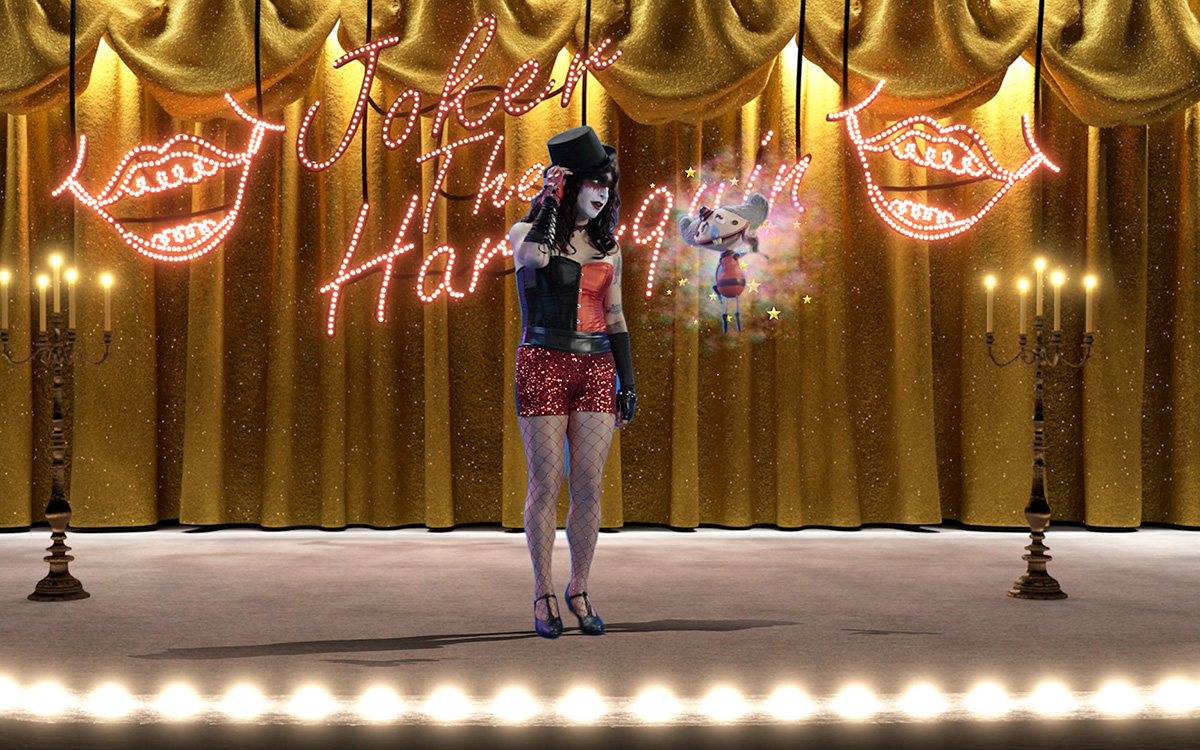
It might come as a shock to some comic book fans, but the idea of super heroes and super villains has always been very queer. Think about it: the dramatic skin-tight costumes, the dual identities and secret lives, the inability to fit in or connect because you are distanced from the “normal” world by your powers – all the standard tropes that define this genre of pop culture myth-making are so rich with obviously queer-coded subtext that it seems ludicrous to think anyone could miss it.
This is not to claim that all superhero stories are really parables about being queer, but, if we’re being honest some of them feel more like it than others; an obvious example is “Batman,” whose domestic life with a teenage boy as his “ward” and close companion has been raising eyebrows since 1940. The campy 1960s TV series did nothing to distance the character from such associations – probably the opposite, in fact – and Warner Brothers’ popular ‘80s-’90s series of film adaptations solidified them even more by ending with gay filmmaker Joel Schumacher’s much-maligned “Batman and Robin,” starring George Clooney and Chris O’Donnell in costumes that highlighted their nipples, which is arguably still the queerest superhero movie ever made.
Or at least it was. That title might now have to be transferred to “The People’s Joker,” which – as it emphatically and repeatedly reminds us – is a parody in no way affiliated with DC’s iconic “Batman” franchise or any of its characters, even though writer, director and star Vera Drew begins it with a dedication to “Mom and Joel Schumacher.” Parody it may be, but that doesn’t keep it from also serving up lots of food for serious thought to chew on between the laughs.
Set in a sort of comics-inspired dystopian meta-America where unsanctioned comedy is illegal, it’s the story of a young, closeted transgender comic (Drew) who leaves her small town home to travel to Gotham City and audition for “GCB” – the official government-produced sketch comedy show. Unfortunately, she’s not a very good comic, and after a rocky start she decides to leave to form a new comedy troupe (labeled “anti-comedy” to skirt legality issues) along with penguin-ish new friend Oswald Cobblepot (Nathan Faustyn). They collect an assortment of misfit would-be comedians to join them, and after branding herself as “Joker the Harlequin,” our protagonist starts to find her groove – but it will take negotiating a relationship with trans “bad boy” Mr. J (Kane Distler), a confrontation with her self-absorbed and transphobic mother (Lynn Downey), and making a choice between playing by the rules or breaking them before she can fully transition into the militant comic activist she was always meant to be.
Told as a wildly whimsical, mixed media narrative that combines live action with a quirky CGI production design and multiple styles of animation (with different animators for each sequence), “People’s Joker” is by no means the kind of big-budget blockbuster we expect from a movie about a superhero — or in this case, supervillain, though the topsy-turvy context of the story more or less reverses that distinction — but it should be obvious from the synopsis above that’s not what Drew was going for, anyway. Instead, the Emmy-nominated former editor uses her loopy vision of an alternative “Batman” universe as the medium for a kind of mythologized autobiography expressing her own real-life journey, both toward embracing her trans identity and forging a maverick career path in an industry that discourages nonconformity, while also spoofing the absurdities of modern culture. Subverting familiar tropes, yet skillfully weaving together multiple threads from the “real” DC Universe she’s appropriated with the detailed savvy of a die-hard fangirl, it’s an accomplishment likely to impress her fellow comic book fans — even if they can’t quite get behind the gender politics or her presentation of Batman himself (an animated version voiced by Phil Braun) as a closeted gay right-wing demagogue and serial sexual abuser.
These elements, of course, are meant to be deliberately provocative. Drew, like her screen alter ego, is a confrontation comic at heart, bent on shaking up the dominant paradigm at every opportunity. Yet although she takes aim at the expected targets – the patriarchy, toxic masculinity, corporate hypocrisy, etc. – she is equally adept at scoring hits against things like draconian ideals of political correctness and weaponized “cancel culture”, which are deployed with extreme prejudice from idealogues on both sides of the ideological divide. This means she might be risking the alienation of an audience which might otherwise be fully in her corner – but it also provides the ring of unbiased personal truth that keeps the movie from sliding into propaganda and elevates it, like “Barbie”, to the level of absurdist allegory.
Because ultimately, of course, the point of “People’s Joker” has little to do with the politics and social constructs it skewers along the way; at its core, it’s about the real human things that resonate with all of us, regardless of gender, sexuality, ideology, or even political parties: the need to feel loved, to feel supported, and most of all, to be fully actualized. That means the real heart of the film beats in the central thread of its troubled connection between mother and daughter, superbly rendered in both Drew and Downey’s performances, and it’s there that Joker is finally able to break free of her own self-imposed restrictions and simply “be” who she is.
Other performances deserve mention, too, such as Faustyn’s weirdly lovable “Penguin” stand-in and Outsider multi-hyphenate artist David Leibe Hart as Ra’s al Ghul – a seminal “Batman” villain here reimagined as a veteran comic that serves as a kind of Obi-Wan Kenobi figure in Joker’s quest. In the end, though, it’s Drew’s show from top to bottom, a showcase for not only her acting skills, which are enhanced by the obvious intelligence (including the emotional kind) she brings to the table, but her considerable talents as a writer, director, and editor.
For some viewers, admittedly, the low-budget vibe of this crowd-funded film might create an obstacle to appreciating the cleverness and artistic vision behind it, though Drew leans into the limitations to find remarkably creative ways to convey what she wants with the means she has at her disposal. Others, obviously, will have bigger problems with it than that. Indeed, the film, which debuted at the 2022 Toronto International Film Festival, was withdrawn from competition there and pulled from additional festival screenings after alleged corporate bullying (presumably from Warner Brothers, which owns the film rights to the Batman franchise) pressured Drew into holding it back. Clearly, concern over blowback from conservative fans – who would likely never see the film anyway – was enough to warrant strong arm techniques from nervous execs. Nevertheless, “The People’s Joker” made its first American appearance at LA’s Outfest in 2023, and is now receiving a rollout theatrical release that started on April 5 in New York, and continues this week in Los Angeles, with Washington DC and other cities to follow on April 12 and beyond.
If you’re in one of the places where it plays, we say it’s more than worth making the effort. If you’re not, never fear. A VOD/streaming release is sure to come soon.
Travel
Hot fun in the desert sun: Your Palm Springs guide
Hiking, dining, bar hopping, and more await
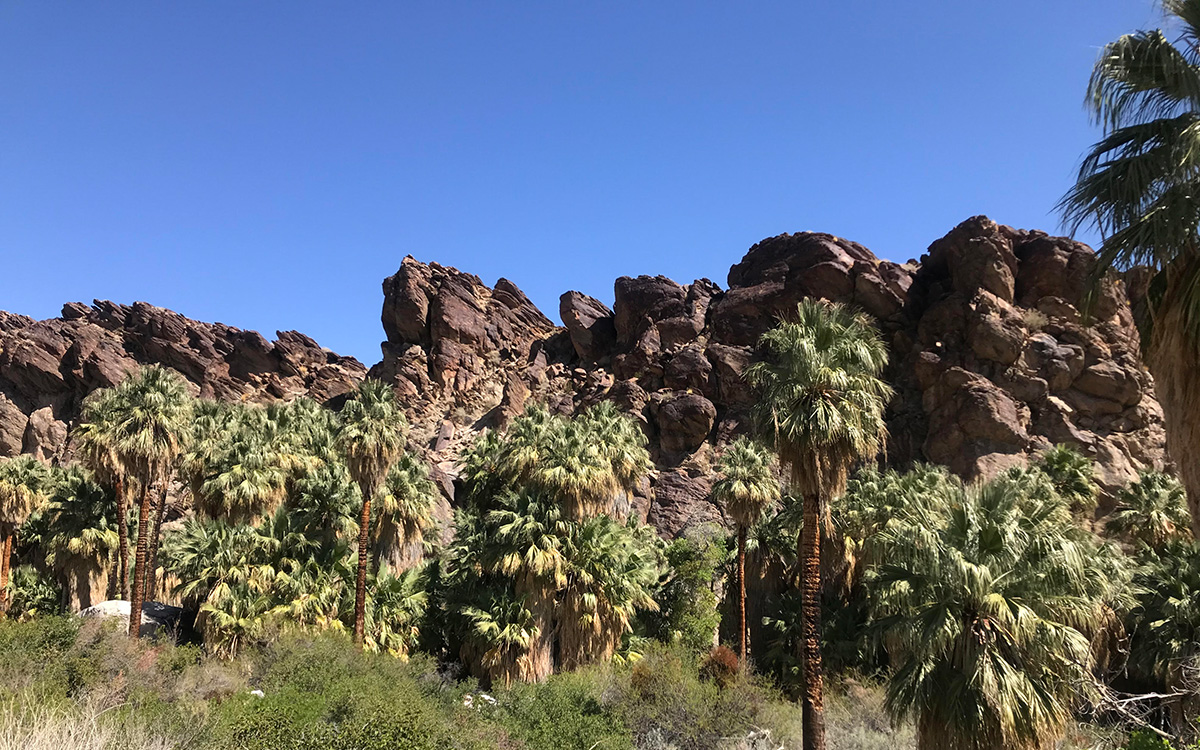
Palm Springs is a favorite destination of mine. I have lots of friends there and there is always something new to do. This trip was no exception. Hiking in two new natural areas. A cabaret shows at Oscar’s. Swimming with the USMS Masters at the Palm Springs Swim Center. A bagel at Townie Bagels and a baguette at Peninsula Pastries. And a cocktail at PSP Air Bar were among the highlights.
WHAT TO DO
Enjoy the Villagefest Thursday night downtown. They block off the street, and it becomes a huge farmers market and art show.
Hit the PS Air Bar for an airline themed evening. They have piano bar Sunday nights in the front. Shop at the Revivals store in the same complex.
Hike in the new Prescott Preserve, formerly a golf course.
Take a hike at the South Lykken Trailhead in Oswit Canyon. Enjoy the cacti and wildflowers. We saw 3 big horn sheep in the meadow. Check out the Oswit Land Trust website for more information.
Go shopping on Sunny Dunes just off South Palm Canyon drive where you will find vintage stores, the Tool Shed leather bar, the new Club 541, antique stores, and a cactus and succulent gift shop (as well as Townie Bagels). Then walk or bike along the new trail along the river just south of Sunny Dunes Road. They even have the plants marked. All are steps from the Motel 6 Downtown.
NIGHTLIFE
Catch a show or go to the Sunday T Dance at Oscar’s. They also have a drag brunch both Saturday and Sunday called “The Bitchiest Brunch.” I saw the fabulous trio, Brandon, and James with Effie, on a Thursday night.
Toucans Tiki Lounge has a popular drag show Monday night. Pick up some new underwear or adult novelty items at the Not So Innocent store next door, 200 N. Palm Canyon.
The Tool Shed at 600 E. Sunny Dunes has a Sunday beer bust and BBQ. They also have an underwear night on Thursdays.
Hunters Palm Springs on Arenas Road has a fun happy hour. (This is the same owner as the one in Wilton Manors, Fla.) You will find 10 other bars nearby.
Fasten your seat belts for the Karaoke Thursday night at PSP Air Bar. The airline themed speakeasy is inside Bouschet. Sit in an old first class American Airlines seat (or an old coach Southwest Airlines seat) while the captain pours you a drink at the PS Air Bar. Then enjoy a show at the Revolution Stage Company next door.
WHERE TO EAT
Grab your morning bagel and coffee at Townie Bagels at 650 East Sunny Dunes. Get there early or expect a line. They open at 6:30 a.m. They are at 650 E. Sunny Dunes Road and have a cult following.
Enjoy a café Americano and pastry at Ristretto For Coffee Lovers (500 S. Palm Canyon Drive).
Enjoy a French baguette or pastry at Peninsula Pastries, 611 S. Palm Canyon in the Sun Plaza. They are only open Thursday to Sunday starting at 8:30 a.m. Get there early to avoid the line. All baked goods use French flour. Like Townie Bagels, they are quite popular. Next door is the Palm Greens Café for a healthy lunch.
Nature’s Health Food and Café (555 Sunrise Way) has fresh juices like carrot juice and vegetarian items like the eggplant wrap. You can sit outside on their patio with your to-go food.
Pick up fruit, yogurt or a pre-made sandwich at Grocery Outlet, Bargain Market in downtown Palm Springs.
GETTING THERE AND GETTING AROUND
I took United through Denver on the way out and through their Houston hub on the way back. United had the best fare and best departure times so I chose them despite my disdain for their policy charging for carry on for basic economy passengers. I had Economy Plus so I got a no charge carry on.
Palm Springs has a cute, small airport with a huge outdoor area. It’s the nicest airport I have ever been to. However, pack something to eat as they have few food options at the moment.
Hop on the #2 SunLine Bus across the street from the airport to go downtown. It’s a two block walk and costs $1. Rental car not needed if you stay downtown. (The lines for the rental cars can be long and they are packed with fees and surcharges.) I used Uber when not taking the SunLine. (SunLine.org)
Leave your bike helmet at home. The city does not have a shared bike system and is not pedestrian friendly outside of the downtown area despite being flat and having a warm climate.
WHERE TO (AND NOT TO) STAY
I stayed at the very handy and very affordable Motel 6 Downtown, 600 S. Palm Canyon. It is across the street from the Sun Plaza, which consists of many shops and restaurant, is a short walk to the bars on Arenas Road, is around the corner from Townie Bagels and the Tool Shed Bar, and more. Rooms are cleaned daily without asking – unheard of with most motels and hotels. The internet is good. No annoying resort fees. Free coffee every morning at 6 a.m. Get a quiet room on the third floor facing east.
Beware of junk fees like resort fees at other Palm Springs hotels. Most hotels in Palm Springs now have them and they are only disclosed on third party booking sites at the end of the reservation process making the room rate look lower than it actually is.
Often, they are lumped under “taxes and fees” to make you think the government requires them. My favorite (not) was the mandatory “community impact fee” at the Hotel Zoso. It is for a mandatory contribution to a charity.
Happily, I have yet to see hotels add a “pillow fee” or “key fee.”
Palm Springs has many lodging options including VRBO and specialty resorts. Men will like the new Twin Palms Resort as well as their sister property, The Descanso Resort. Both are excellent. Service is top notch. Lunch catered everyday. And more.
MORE INFORMATION
GED is the local magazine. RAGE Monthly out of San Diego also covers PS as does the Los Angeles Blade.
The weekly is the Coachella Valley Independent, which covers upcoming events, restaurants, hikes, local politics and more.
Palm Springs also has a gay radio station. Pick up a copy of their KGay desert Guide or view them at kgaypalmsprings.com (106.5 on the FM dial).
You won’t run out of fun things to do in Palm Springs and summer is their value season.
There is nowhere else where you can enjoy the desert sun surrounded to the west and north by snow capped mountains. And you won’t find a gayer city anywhere.
Bill Malcolm is an award-winning travel writer. His syndicated travel column in run by select LGBTQ publications throughout North America. You can find him on Facebook and read his columns at the travel blog section of the IGLTA website. He received no compensation of any kind for this column.
-
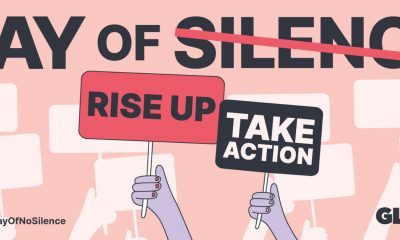
 LGBTQ Non-Profit Organizations5 days ago
LGBTQ Non-Profit Organizations5 days agoDay of [no] silence, a call to speak out against anti-LGBTQ+ hate
-

 Africa1 day ago
Africa1 day agoCongolese lawmaker introduces anti-homosexuality bill
-

 Colorado3 days ago
Colorado3 days agoFive transgender, nonbinary ICE detainees allege mistreatment at Colo. detention center
-
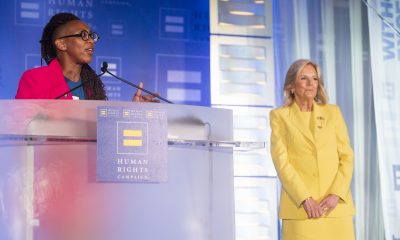
 Politics4 days ago
Politics4 days agoFirst lady warns Trump is ‘dangerous to the LGBTQ community’ at HRC event

